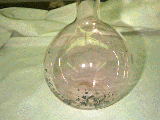Definitions of Chemistry
Definition of Matter
The two distinguishing characteristics of matter is that matter is classified as anything that has mass and occupies space.
Composition of Matter
Pure substances
-
matter that has a fixed composition and distinct physical and chemical properties.
Atoms
Matter is composed of atoms.
- Atoms are the smallest particles of an element that retain the chemical properties of the element.
- An element is an example of matter which consists of only one kind of atom, either individually or combined into larger units.
Molecules
Molecules are units of matter consisting of two or more atoms combined in a definite ratio.
- When the atoms are the same in a molecule the substance is an element.
- When the atoms are different the substance is considered a compound.
Mixtures
-
combinations of two or more substances where each substances retains its chemical identity (its physical and chemical properties).
-
heterogeneous mixtures do not have the same composition, properties or appearance.
-
homogeneous mixtures do have the same composition, properties or appearance.
Diagram of an STM instrument.
Some STM Images of atoms and or molecules.
Characterization of Matter
To characterize matter we use physical and chemical properties.
Physical properties are properties that can be measured and observed without changing the identity of the substance.
- State(gas, liquid and solid)
- Color
- Melting Point (Important to note that a change in phase, which occurs at the boiling point or melting point of a substance does not necessarily mean a chemical change has occurred.)
- Boiling Point
- Density
- Texture
- Hardness
Also important are
- Mass
- Volume
but these properties have less to do with distinguishing between substances.
 | The obvious physical properties are that sulfur is a yellow solid (rhombic sulfur). Less obvious but which we can locate in a reference book or textbook is that sulfur has a melting point of 112.8 C and boils at 444.6 C. Several allotropic forms exist. Orthorombic sulfur density is 2.069 g/cm3, monoclinic (at 95 C) has a density of 1.94 - 2.01 g/cm 3. |
 | Silvery, heavy, moveable liquid. Its melting point is -38 C, boiling point is 356 C. It has a very high density at 13.5 g/cm3. Mercury is readily enhaled. It is not so much of a hazard when ingested. Spilled mercury should be cleaned up immediately to prevent long term, low-level exposure. |
 | Iodine is black looking solid at room temperature and readily forms a violet vapor. The solid has a metallic luster and forms plates or scales. The vapor is corrosive with a sharp odor. Its melting point is 114 C, boiling point is 184 C and it has a density of 4.94 g/cm3. Iodine is not very soluble in hot or cold water, but it is soluble in solvents like alcohol, benzene and ether. Iodine is found in seawater. Ingestion of 2 to 4 grams have been known to be fatal. |
 | Nitrogen dioxide, NO2, is a brownish-red gas at room temperature. It is sealed in the glass tube to confine it and to protect us. Nitrogen dioxide is a poisonous gas. In the Merck Index Nitrogen dioxide is described as an 'insidious gas'. The gas can be fatal at a level of 200 ppm, and dangerous at 100 ppm. Its melting point is -9.3 C and it boils at 21 C. Its density is 3.3 grams/liter. |
Chemical properties are also used to characterize matter.
Chemical properties involve the transformation of substances into other substances.
Note: Sample chemical reactions were demonstrated and discussed in class.
Atomic Theory and a Microscopic Model of Matter
It was a gentleman by the name of John Dalton who organized a collection of experimental observations into a theoretical framework. Dalton, who was a meteorologist, had considerable experience with air and wind and the effects of temperature on the volume of a gas. The results of his study of air suggests that his observations could be understood if matter consisted of tiny particles, a sort of submicroscopic billard ball. So Dalton proposed his atomic theory to explain his observations.
Each element is made up of tiny, indivisible particles called atoms.
- All atoms of a given element possess identical properties.
- Atoms of different elements have different properties.
- Chemical changes involve the combination, separation or rearrangement of atoms: atoms are neither destroyed, created or changed.
- When atoms combine they do so in fixed ratios of whole numbers forming particles called molecules.
Click here to view a figure of this microscopic model.